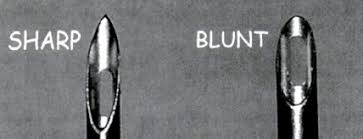Most often in the United States, the first type of needle employed for initial cannulations will be a sharp metal needle, whether to begin rope ladder/rotating site technique, or same-site cannulation in order to establish tunnel tracks for the buttonhole technique. Alternatively, plastic cannulas, or pegs, have been left in the vessel for a period of time to develop the buttonhole tunnel track.

Metal needles are made of stainless steel, and are either sharp or blunt. Sharp needles, used for the rope ladder technique, have a sharp cutting edge, whereas blunt needles, designed for the buttonhole technique, are rounded on top and do not have a sharp edge. GLT AV Fistula picture shows the difference between the ends of a sharp and a blunt needle.
Metal needles have a silicone coating for smooth insertion and low flow resistance.
17 In certain buttonhole patients, blunt needles may bounce off the vessel during entrance into the track, and therefore sharp needles are recommended.18,19 Some needles have an intermediary sharpness between that of traditional sharp and blunt needle tips. The buttonhole technique is only used with extensive specialized staff training for AVFs and never in arteriovenous grafts (AV Fistula needle).
